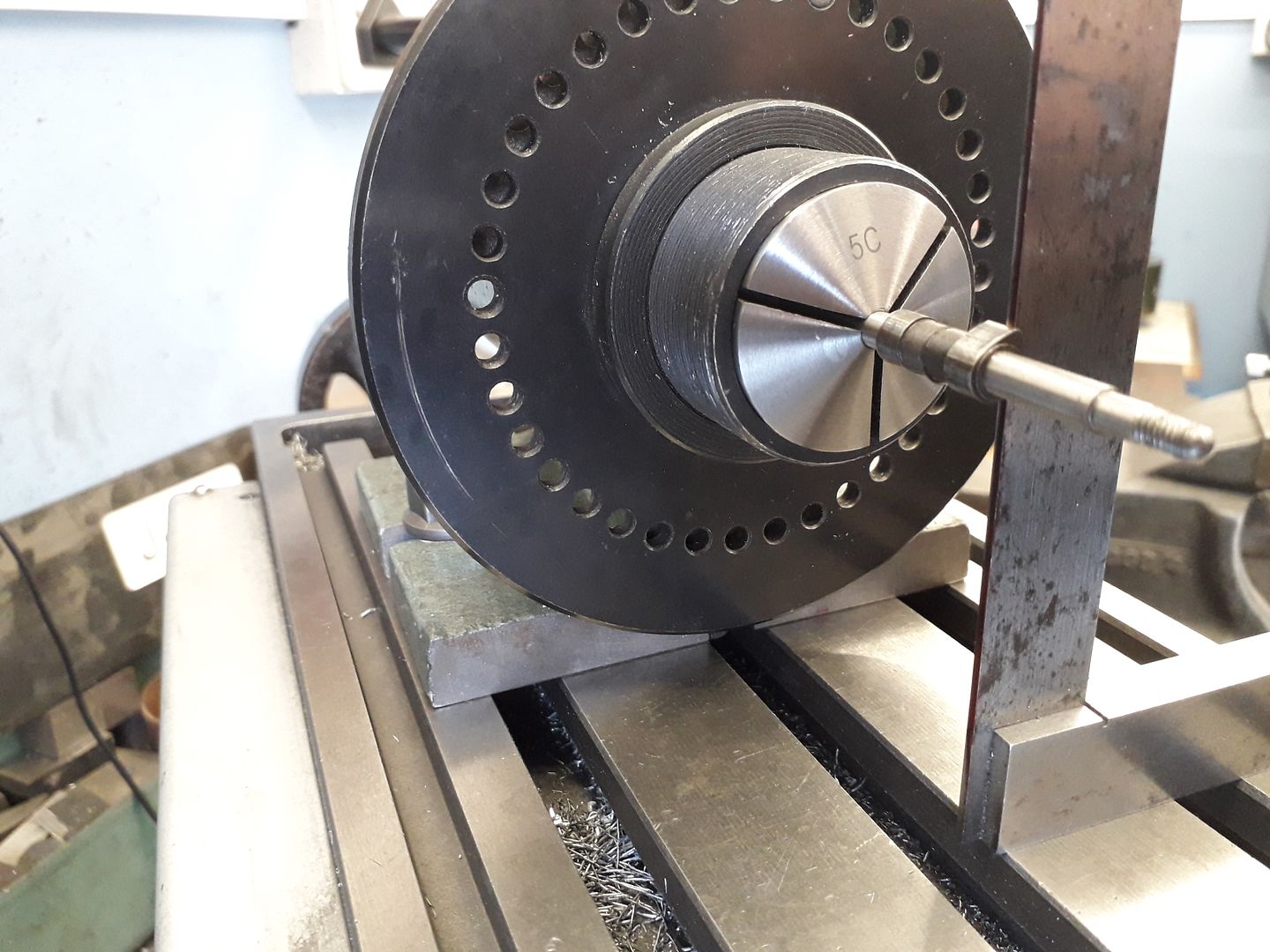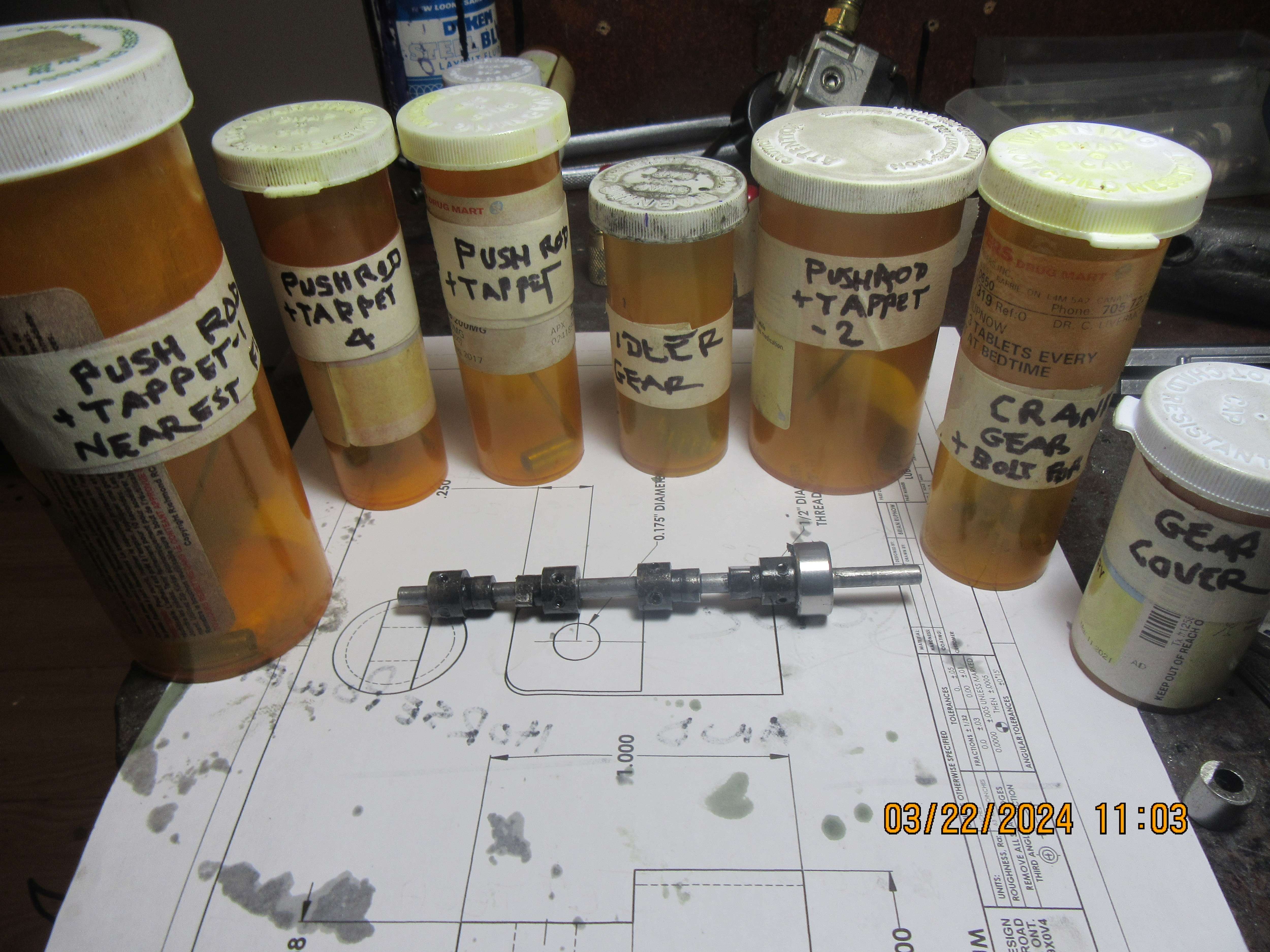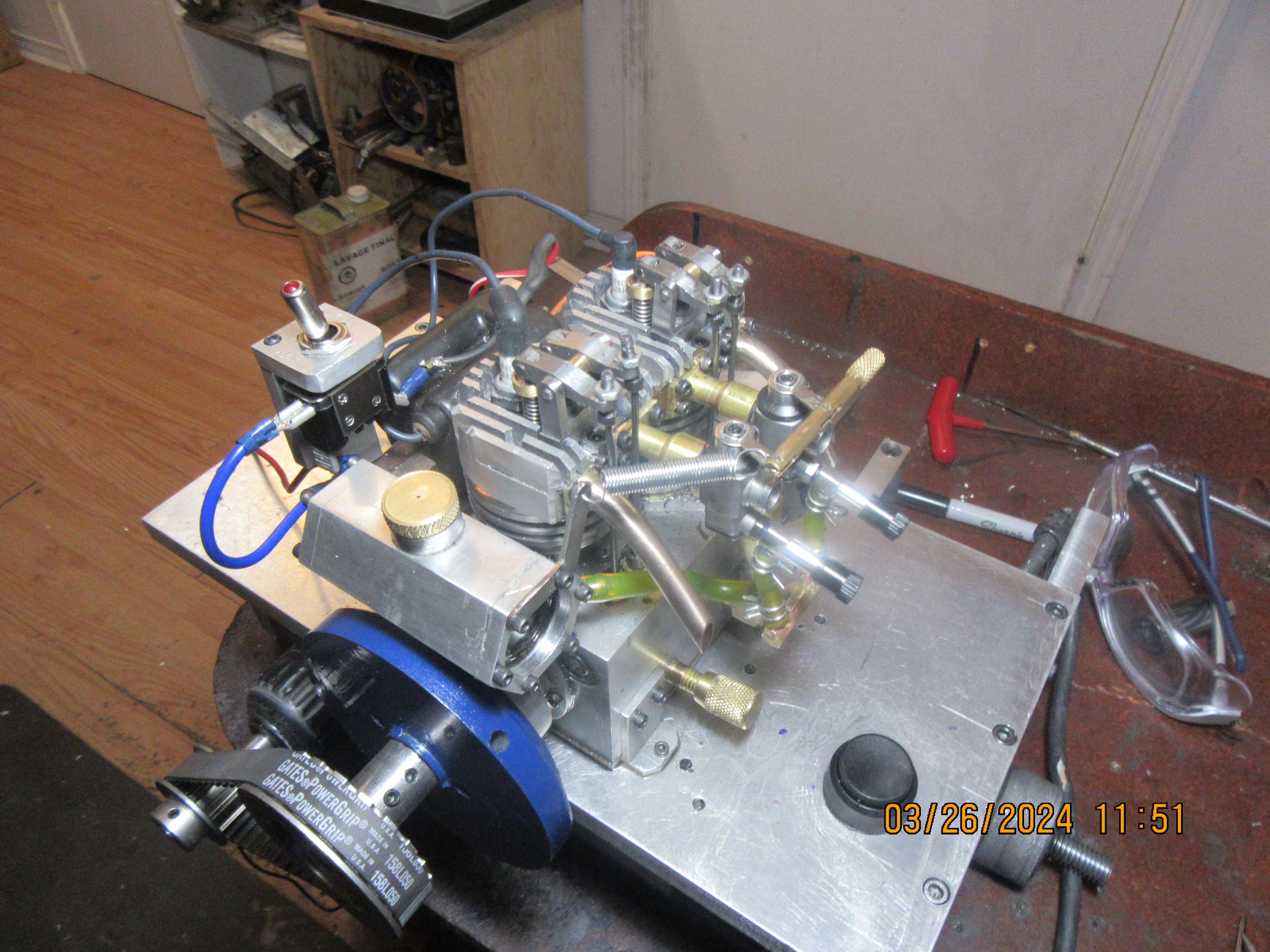appears to be separationin degrees between intake and exhaust cam lobe centers. Also, the lobes lobes for the two cylinders appear to be identically in line, that is the intake/exhaust timing is identical for both cylinders.
You are using an out of date browser. It may not display this or other websites correctly.
You should upgrade or use an alternative browser.
You should upgrade or use an alternative browser.
Building a twin cylinder inline i.c. engine.
- Thread starter Brian Rupnow
- Start date

Help Support Home Model Engine Machinist Forum:
This site may earn a commission from merchant affiliate
links, including eBay, Amazon, and others.
The two black arcs represent the duration of the cam in relation to crank angle. draw a radial line through the mid points of the two black arks to represent the peak of the lobe and the angle between the two is 205degrees of crank rotation.
As the cams are positioned on the cam shaft which rotates at twice the amount you need to half the angle which equals 102.5deg of camshaft rotation.
As the cams are positioned on the cam shaft which rotates at twice the amount you need to half the angle which equals 102.5deg of camshaft rotation.
Attachments
Jason and Sparky--Thank you very, very much.---Brian
Last edited:
I changed out my 300 psi pressure gauge for a 60 psi pressure gauge. I got rid of the flex line. Still, no pressure showing up on my compression tester when I turn the engine over a number of times. I spoke to Andrew Whale in the U.K. about these results, but he said that he has had the same result show up when he tried to do a compression check on the small engines which he builds so successfully.
Since I have had it explained to me so well, I think I will pull the camshaft out of the engine and set it up in the 3 jaw chuck on my rotary table to set the correct angle on all four cams that are attached to it. My rotary table can be mounted in two positions, so that the centerline of the 3 jaw chuck can be vertical or horizontal, whichever I choose. Setting the cams this way is something that I have never done before, but then I've never built a twin cylinder inline engine before. The more I do, the more I learn.---Brian
Does your compression tester have a check valve? Many don't, and the dead volume of the tester itself messes up the compression ratio of small cylinders causing incorrect low readings.I changed out my 300 psi pressure gauge for a 60 psi pressure gauge. I got rid of the flex line. Still, no pressure showing up on my compression tester when I turn the engine over a number of times. I spoke to Andrew Whale in the U.K. about these results, but he said that he has had the same result show up when he tried to do a compression check on the small engines which he builds so successfully.

$40.92
$74.95
Revell 85-8883 1/4 Visible V-8 Engine Plastic Model Kit, 12-Inch,Multi-Colored
Most-Models com
That is the way I said to set the cams in the first place, it is the way Malcom shows in his article as well. Different engine but how I did it with flat flank cams.


Armed with new knowledge thanks to helpful forum members, I am going to set out today to set up my engine cam positions using a 3 jaw chuck and rotary table. This is going to be time consuming but I have great hopes for a running engine using this method. Setting cams using this method should be one of the last great mysteries about small engine building. I will keep you posted about the operation.---On the previous method I have used in the past, I have used a "timing dial" registered in degrees, and revolved the individual cam segments until my dial indicator held on the rocker arm registered some specified number of degrees before top or bottom dead center, then locked the cam segment in position on the cam, then moved on and done the same for the other valve. ---In this case, I will set all of the cams in position outside of the engine and when I install the cam I will still use the same method, only this time instead of repeating it with every individual cam segment I will do it for the first cam closest to the flywheel, and the rest of the cams should automatically be in the correct position.---Brian
Here it is--the camshaft, freshly pulled from the engine. Arranged behind it are all the parts I had to remove from the engine to do so. I started dismantling at about 9:30 and it's 11:25 now. I haven't looked at the cams yet, as to how they were arranged.


Unless somebody gives me good reason not to, I'm going to set all the cam lobes with the cam out of the engine, using my rotary table to dial in the correct number of degrees between cam lobes. The camshaft gear is not keyed to the camshaft, so I will not setscrew the cam gear to the camshaft yet. Before I tighten the setscrews on the cam gear, I will manually turn the camshaft in the correct direction until the exhaust valve on the cylinder closest to the flywheel begins to open at 40 degrees before the piston reaches bottom dead center (as indicated by a dial indicator on the exhaust valve rocker arm), lock up the set screws on the cam gear and I should then be good to go. All the cam sections are set before I install the cam, so all the rest of the cams should be in the correct rotational position.
Setting up the cams rotationally with the rotary table and a notched cam locating "stick" which has he cam's v-shaped profile cut into it is probably one of the easiest things I have ever done. There is only one thing to screw up here, and that is to determine if the exhaust valves lead when the cam turns clockwise---or not. I have slid the camshaft back into the engine and will put the tappets and pushrods back into place and see if I have guessed right. Malcolm's engine turns counterclockwise when it runs, my engine runs clockwise. I think that my exhaust cams "lead" when rotating the camshaft clockwise because of the fact that my engine runs in reverse to Malcolm's. I'll know in about 10 minutes.
It's been a long 10 minutes, but I think everything is happening in the correct sequence. As the piston closest to the flywheel is going down on the power stroke, the piston farthest from the flywheel is going down on the intake stroke. I'm going to assume that YES I have it right and start putting everything back together.
- Joined
- Jan 4, 2011
- Messages
- 1,435
- Reaction score
- 401
So were your cams near the correct position prior to setting them up with the rotary table? From everything that you have said before it seems to me that incorrect cam position is the most likely problem. You have not been able to get compression in the same cylinder but putting pressure in that cylinder with the air compressor does not find any obvious leaks and swapping ignition and fuel does not make any difference.It's been a long 10 minutes, but I think everything is happening in the correct sequence. As the piston closest to the flywheel is going down on the power stroke, the piston farthest from the flywheel is going down on the intake stroke. I'm going to assume that YES I have it right and start putting everything back together.
Gordon--The cylinder closest to the flywheel which had been firing as I drove the motor with my drill was "close" in terms of cam position. The cylinder farthest from the flywheel was way out.
You live and learn!
Well done Brian.
Well done Brian.
The engine is back together and ready for another try. Everything has went according to plan. I went to a grandsons hockey game this morning and spent the afternoon doing a final reassembly. I even got a little paint on the larger flywheel, which was made from a pulley I had made a couple of years ago for something. Wish me luck.
Hi Brian, If one cylinder is firing the the cams for the other cylinder should be exactly 180 degrees opposite in the direction of rotation check this out and you should have compression and a beautiful running engine to be proud of.JohnThe engine is back together and ready for another try. Everything has went according to plan. I went to a grandsons hockey game this morning and spent the afternoon doing a final reassembly. I even got a little paint on the larger flywheel, which was made from a pulley I had made a couple of years ago for something. Wish me luck.
So----The engine is finished. This build has carried me thru January, February, and March. It started out as one carburetor feeding a single manifold that spanned between both cylinders. As the engine evolved, I couldn't get the single manifold spanning between both cylinders to seal properly, so the cylinders were fitted with one carburetor each and a single intake manifold each to get away from the sealing problem. Some confusion on my part lead to having to ask for some help when setting up the individual cams on the camshaft, and I feel that I have indeed learned something new. I never was able to come up with a 12 volt coil that had dual outputs, so I "borrowed" the 12 volt coil of my dual opposed cylinder engine because I know it works. I made a new style of gas tank based on one that Andrew Whale from the U.K. built, with glass ends and I like it very much.---I can now see at a glance if the engine has ran out of fuel or not. Only one problem remains, and that is that I can't get the damned engine to run!! I will continue pecking away at things until I have a runner, and then I will probably post the engine drawings for sale. Although this engine was base on Malcolm Stride's engine, the Jaguar, it has a different bore, different stroke, different ignition and different lubrication system. Thank you all, readers, for following the build.---Brian Rupnow--26-March--2024


- Joined
- Jan 4, 2011
- Messages
- 1,435
- Reaction score
- 401
At this point you have two single cylinder engines mounted on a common base plate. You have separate carburetors, separate ignitions, separate cams. Engine #1 runs but engine #2 does not run so what is different about engine #2? Does engine #2 now have compression? Is engine #2 receiving spark? Is engine #1 firing and blowing back into the common intake manifold so that #2 is not receiving fuel?
AndrewW
Well-Known Member
Hi BrianSo----The engine is finished. This build has carried me thru January, February, and March. It started out as one carburetor feeding a single manifold that spanned between both cylinders. As the engine evolved, I couldn't get the single manifold spanning between both cylinders to seal properly, so the cylinders were fitted with one carburetor each and a single intake manifold each to get away from the sealing problem. Some confusion on my part lead to having to ask for some help when setting up the individual cams on the camshaft, and I feel that I have indeed learned something new. I never was able to come up with a 12 volt coil that had dual outputs, so I "borrowed" the 12 volt coil of my dual opposed cylinder engine because I know it works. I made a new style of gas tank based on one that Andrew Whale from the U.K. built, with glass ends and I like it very much.---I can now see at a glance if the engine has ran out of fuel or not. Only one problem remains, and that is that I can't get the damned engine to run!! I will continue pecking away at things until I have a runner, and then I will probably post the engine drawings for sale. Although this engine was base on Malcolm Stride's engine, the Jaguar, it has a different bore, different stroke, different ignition and different lubrication system. Thank you all, readers, for following the build.---Brian Rupnow--26-March--2024

Thanks for the mention. I hope you manage to get the engine running at some point. Don't give up!
Cheers
Andrew
Similar threads
- Replies
- 510
- Views
- 69K
- Replies
- 27
- Views
- 7K
- Replies
- 95
- Views
- 12K













